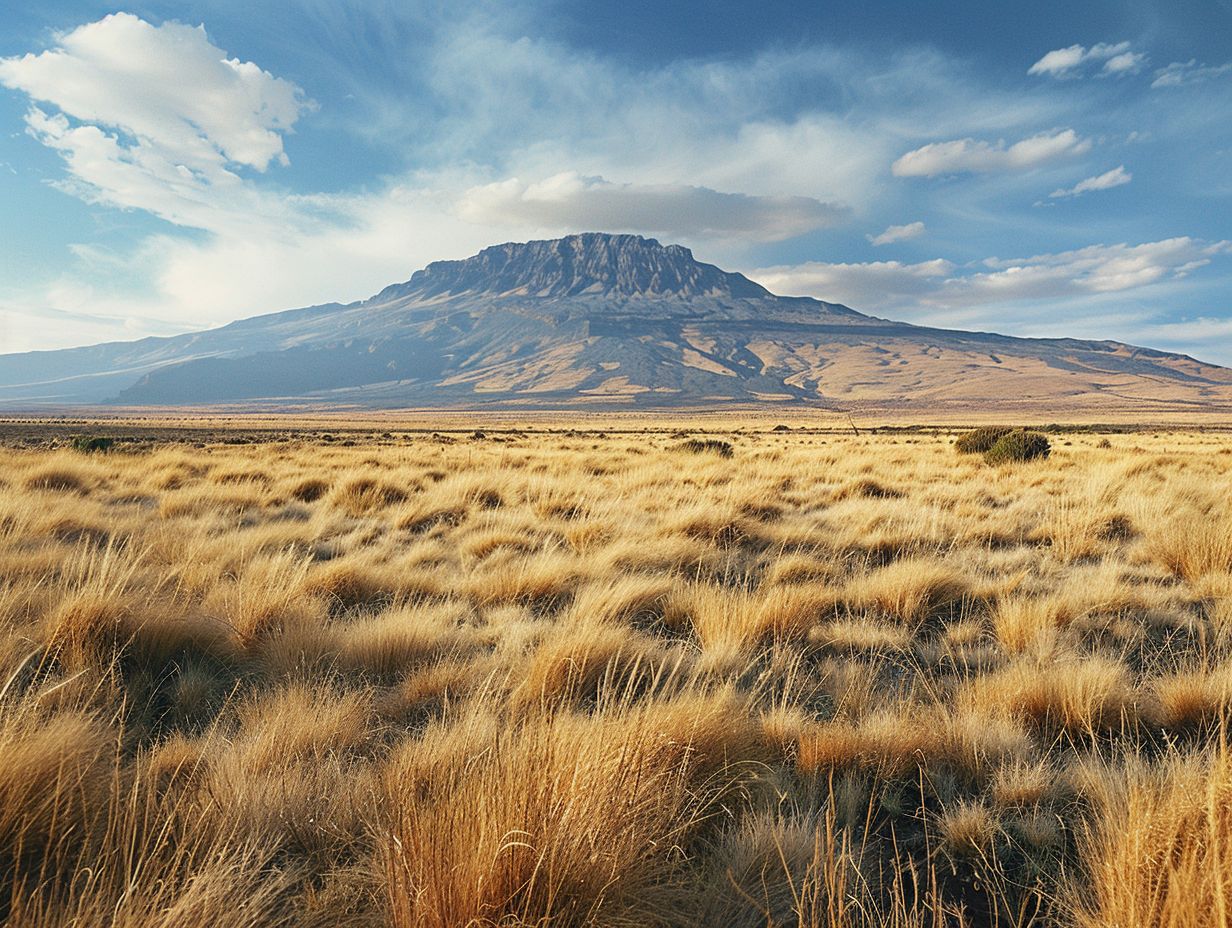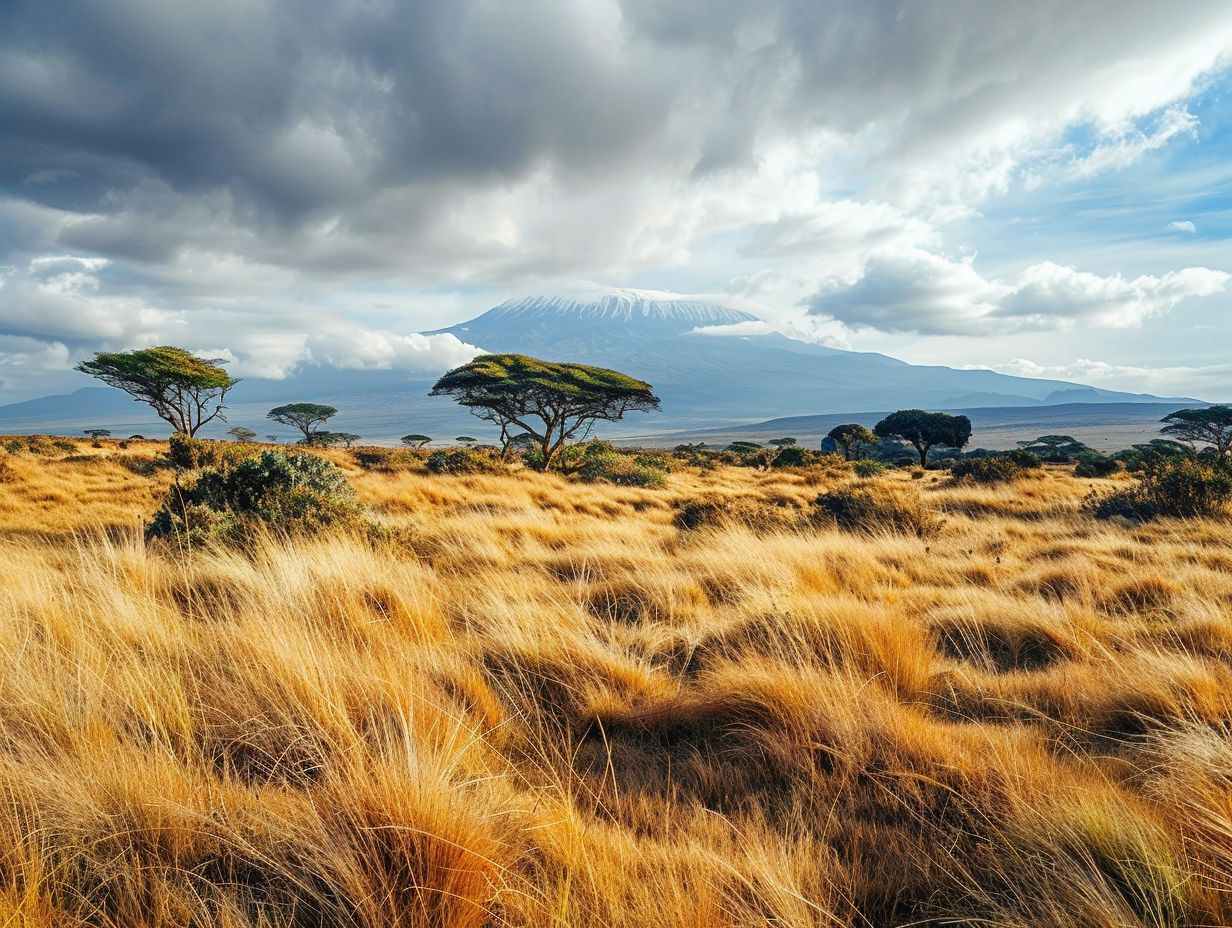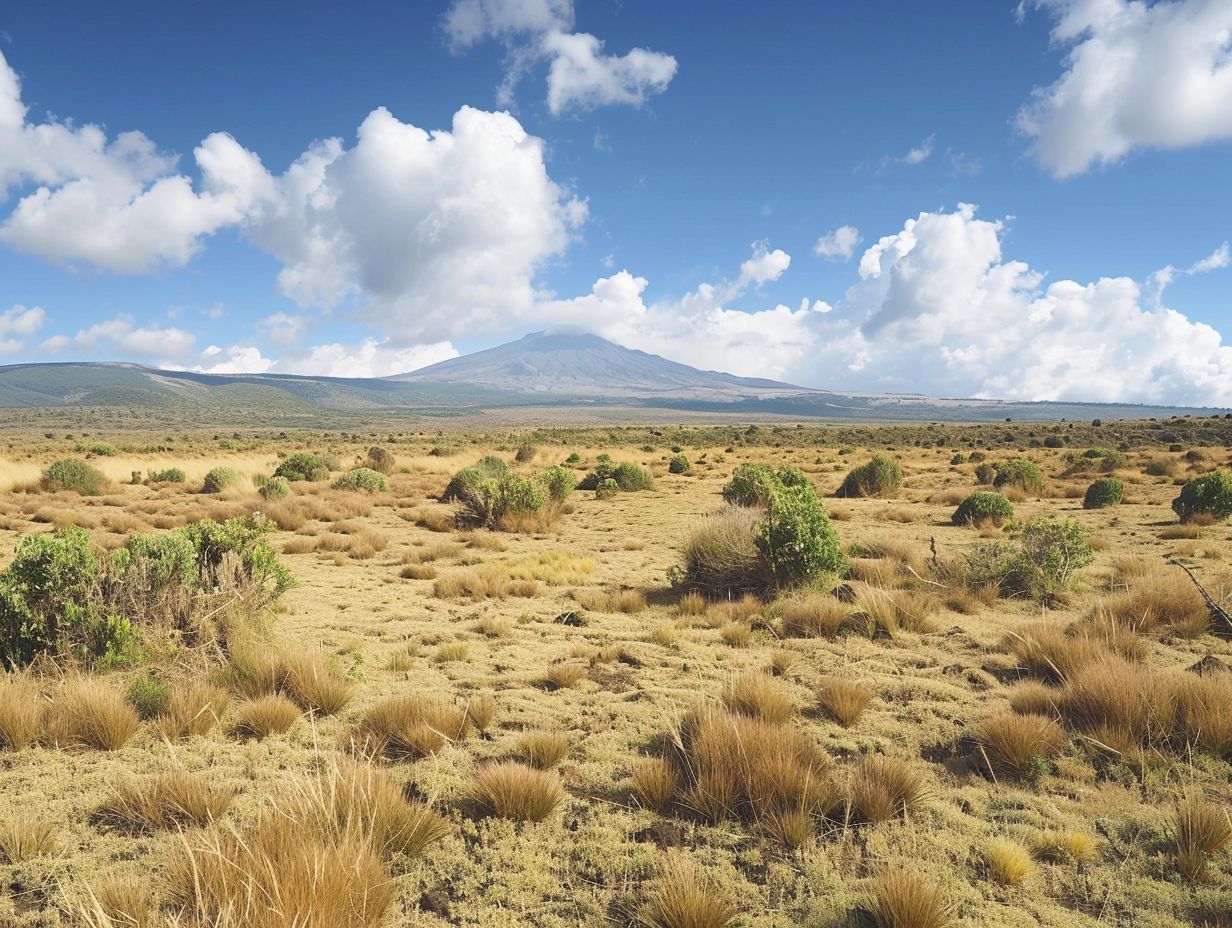
Moorland Heath Zone Kilimanjaro
Nestled in the majestic Kilimanjaro, the Moorland Heath Zone is a fascinating ecological region that holds a wealth of importance for the ecosystem.
From its unique climate and diverse vegetation to its rich wildlife, this zone plays a crucial role in regulating water, protecting soil, and preserving biodiversity.
This precious landscape faces threats from climate change and human activities.
To safeguard the Moorland Heath Zone, sustainable tourism, conservation efforts, and community involvement are essential.
Explore the characteristics, significance, threats, and preservation strategies of this remarkable zone.
Key Takeaways:

- The Moorland Heath Zone is a unique ecosystem on Mount Kilimanjaro with distinct characteristics such as a cool climate, diverse vegetation, and abundant wildlife.
- As an important part of the ecosystem, the Moorland Heath Zone provides essential services like water regulation, soil protection, and biodiversity conservation.
- However, the Moorland Heath Zone is facing threats from climate change and human activities, and it is crucial to preserve it through sustainable tourism, conservation efforts, and community involvement.
What Is the Moorland Heath Zone in Kilimanjaro?
The Moorland Heath Zone in Kilimanjaro is a unique ecological zone characterized by its high altitude and distinct vegetation. Located in Tanzania, this zone is part of the diverse ecosystems found on Mount Kilimanjaro, showcasing the geographical richness of the region.
At elevations ranging from 2,800 to 4,000 meters above sea level, the Moorland Heath Zone offers a striking transition from the lower montane forest below. The vegetation here consists of hardy shrubs, tussock grasses, and lichens that have adapted to the challenging conditions of lower temperatures and thin soils.
This zone plays a vital role in the broader ecosystem of Kilimanjaro, serving as a crucial habitat for various species of flora and fauna and acting as a buffer zone between the moister forest zones and the alpine desert higher up.
What Are the Characteristics of the Moorland Heath Zone?
The Moorland Heath Zone on Kilimanjaro is distinguished by its specific climate, vegetation cover, and diverse wildlife. This zone, situated at varying altitudes, supports a range of flora and fauna found only in this unique region of Tanzania.
The Moorland Heath Zone experiences cool temperatures and high rainfall, creating an ideal environment for heath vegetation such as tussock grass, lobelias, and everlasting flowers.
The abundance of mosses and lichens adds to the rich tapestry of plant life in this zone.
Noteworthy wildlife species, such as elands, buffaloes, and various bird species, thrive in the Moorland Heath Zone, relying on the vegetation for food and shelter.
-
Climate:
The climate in the Moorland Heath Zone of Kilimanjaro is influenced by its altitude, resulting in temperature changes, varying precipitation levels, and unique humidity patterns. The zone’s isolated climates create diverse microclimates, with fluctuating temperature ranges and exposure to different wind patterns.
As one climbs higher into the Moorland Heath Zone of Kilimanjaro, the impacts of altitude on the climate become increasingly pronounced. Altitude directly influences temperature, with a general trend of decreasing temperatures with increasing altitude. This phenomenon occurs due to the lower air pressure at higher altitudes, resulting in cooler temperatures.
Along with temperature variations, precipitation levels are also affected by altitude. Areas at higher altitudes typically experience higher levels of precipitation due to the orographic effect, where moist air is forced to rise and cool, leading to condensation and rainfall.
Humidity levels in the Moorland Heath Zone vary significantly with altitude. Lower altitudes tend to have higher humidity levels due to proximity to water bodies, while higher altitudes experience drier air. These humidity fluctuations play a crucial role in shaping the vegetation and ecological systems in the zone.
-
Vegetation:
The vegetation in the Moorland Heath Zone of Kilimanjaro includes a mix of flora such as forests, bushlands, and unique plant species. This vegetation contributes to the rich ecosystems of Kilimanjaro National Park, showcasing the importance of soil quality and cultivation practices in sustaining the diverse plant life.
The various types of flora found in the Moorland Heath Zone play integral roles in the ecosystem. Forests provide habitats for wildlife, while bushlands offer nesting sites for birds and small mammals.
Unique plant species add to the biodiversity of the region, enhancing its ecological value. Soil conditions, including the pH level and nutrient content, greatly influence the growth and distribution of vegetation. Cultivation methods, such as controlled burning or rotational grazing, are essential for managing plant diversity and preventing invasive species from taking over.
-
Wildlife:
The wildlife in the Moorland Heath Zone of Kilimanjaro is characterized by its biodiversity, encompassing a variety of animals and plant species that are integral to the local ecosystems. These unique wildlife populations contribute to the overall richness of the region, making the summit of Kilimanjaro a hotspot for observing diverse African wildlife.
Within this zone, visitors can witness fascinating interactions between various species, such as the giant groundsels that provide shelter for small mammals like the native mole rats. The presence of endemic bird species, including the Scarlet-tufted Malachite Sunbird and the Tacazze Sunbird, adds a splash of color to the landscape, further highlighting the biodiversity of the area.
The interconnectedness between different plants and animals in this zone is crucial for maintaining the delicate balance of the ecosystem. For instance, the Senecio kilimanjari plants serve as a vital food source for herbivores like the elands and mountain zebras, playing a significant role in the food chain.
By protecting and preserving the diverse wildlife found in the Moorland Heath Zone, we can ensure the continued health and sustainability of Kilimanjaro’s ecosystem, safeguarding these species for future generations to enjoy and appreciate.
How Is the Moorland Heath Zone Important for the Ecosystem?

The Moorland Heath Zone plays a vital role in the ecosystem of Kilimanjaro by regulating water flow, protecting the soil from erosion, and enhancing biodiversity within the region. Its unique vegetation cover and diverse ecosystems contribute significantly to the overall balance and sustainability of Kilimanjaro National Park.
The Moorland Heath Zone acts as a crucial buffer zone, absorbing excess water during heavy rains, thus preventing floods downstream and ensuring a stable water supply for vegetation and wildlife. The dense vegetation in this zone helps in conserving soil by holding it together, reducing erosion caused by wind and rain, and maintaining the fertility of the land over time.
The rich biodiversity supported by the Moorland Heath Zone provides habitat for various plant and animal species, some of which are endemic to the region. This diversity not only contributes to the overall ecological health of the area but also enables scientific research and conservation efforts focused on safeguarding these unique ecosystems.
-
Water Regulation:
Water regulation in the Moorland Heath Zone of Kilimanjaro is critical for maintaining ecological balance, as the zone’s vegetation, altitude variations, and unique drainage systems influence precipitation patterns, humidity levels, and elevation gradients. This regulation ensures sustainable water flow throughout the region.
The precipitation in this area plays a crucial role in replenishing the groundwater levels and sustaining the delicate balance of the ecosystem.
Drainage systems within the Moorland Heath Zone impact how the water flows across the landscape, affecting soil moisture and plant distribution. Vegetation types, ranging from heathers to shrubs, help retain water and prevent soil erosion, contributing to the overall water balance of the region. Moreover, altitude variations influence the intensity and distribution of rainfall, impacting the water availability in different parts of the zone.
-
Soil Protection:
Soil protection in the Moorland Heath Zone of Kilimanjaro is crucial for maintaining the fertility and stability of the region’s land. The zone’s vegetation and agricultural practices play a significant role in preserving the soil quality and supporting sustainable cultivation methods, thereby safeguarding the ecosystem of Kilimanjaro National Park.
Vegetation cover in the Moorland Heath Zone acts as a natural shield, preventing erosion and nutrient depletion. The diverse plant species in the area contribute to soil aeration, water retention, and organic matter decomposition, enhancing soil structure and fertility. The agricultural activities practiced in harmony with the environment, such as crop rotation and organic farming, help minimize soil degradation and chemical contamination.
Conservation efforts, including reforestation programs and erosion control measures, further bolster the soil’s resilience and biodiversity. By nurturing healthy soil conditions, these initiatives not only protect the delicate ecosystem but also support sustainable land use practices for future generations.
-
Biodiversity:
Biodiversity in the Moorland Heath Zone of Kilimanjaro is a testament to the rich flora, fauna, and wildlife diversity present within this unique ecosystem. The interdependence of various plant and animal species, influenced by the zone’s vegetation cover and climate conditions, contributes to the overall biodiversity of Kilimanjaro.
The Moorland Heath Zone, characterized by its extensive heathlands, tussock grasses, and scattered shrubs, provides a habitat for an array of species such as giant lobelias, Senecio plants, and various endemic insects and birds specific to this altitude. The unique vegetation types, including Erica arborea and Erica trimera, create microhabitats that support a diverse range of organisms, showcasing how plant diversity directly influences the animal population dynamics within the ecosystem.
What Are the Threats to the Moorland Heath Zone?
The Moorland Heath Zone faces various threats, including the impacts of climate change and human activities that pose risks to the delicate balance of the ecosystem on Kilimanjaro. These threats endanger the vegetation, wildlife, and overall sustainability of the region, requiring urgent conservation measures.
Climate change has exacerbated the frequency and intensity of wildfires, leading to the destruction of crucial plant species and habitats within the Moorland Heath Zone. Human activities such as deforestation, agriculture, and infrastructure development further fragment the already vulnerable ecosystem, disrupting natural processes and decreasing biodiversity.
Conservation strategies such as reforestation programs, controlled burns, and sustainable land management practices are crucial for restoring the health of the Moorland Heath Zone. Engaging local communities in conservation efforts and implementing policies to regulate human impacts are essential steps to safeguarding this ecologically significant area.
-
Climate Change:
Climate change poses a significant threat to the Moorland Heath Zone of Kilimanjaro, leading to alterations in temperature patterns, shifts in precipitation levels, and disruptions in the region’s weather systems. These environmental changes impact the fragile ecosystems and vegetation cover, endangering the biodiversity of Kilimanjaro.
The rising temperatures in the Moorland Heath Zone cause permafrost to melt, affecting the water availability and soil structure essential for plant growth. With increased temperatures, there is a rise in evapotranspiration rates, leading to water stress in plants and hindering their ability to thrive.
This shift also influences the precipitation patterns, altering the timing and amount of rainfall, which in turn affects plant species adapted to specific moisture levels.
-
Human Activities:

Human activities such as settlements and agricultural practices near the Moorland Heath Zone of Kilimanjaro pose a threat to the natural habitat, vegetation, and wildlife populations in the region. The encroachment of human settlements and unsustainable farming methods contribute to the degradation of ecosystems and loss of biodiversity.
As human populations expand and demand for resources increases, the consequences on the Moorland Heath Zone become more pronounced. The conversion of land for residential and agricultural purposes disrupts the delicate balance of the ecosystem, leading to habitat fragmentation and destruction.
This fragmentation isolates wildlife populations, limiting their ability to roam freely and access crucial resources. Pollution from agricultural runoff and waste further contaminates the soil and water sources, impacting not just the local flora and fauna but also the broader ecological stability.
How Can the Moorland Heath Zone Be Preserved?

Preserving the Moorland Heath Zone requires a concerted effort involving sustainable tourism practices, conservation initiatives, and active community involvement in Kilimanjaro.
Through the implementation of tailored conservation projects and entrenching community engagement initiatives, the delicate balance of ecosystems within the Moorland Heath Zone can be upheld.
Protecting the unique flora and fauna of Kilimanjaro is paramount in sustaining the region’s ecological integrity.
By fostering awareness among locals and visitors alike, a culture of conservation can be fostered, ensuring the long-term resilience and vitality of the surrounding environment.
-
Sustainable Tourism:
Sustainable tourism practices play a crucial role in preserving the Moorland Heath Zone of Kilimanjaro, promoting biodiversity conservation, and supporting local communities in Tanzania. By fostering responsible tourism initiatives, visitors can contribute to the protection of the zone’s ecosystems and the sustainable development of the region.
Through sustainable tourism, the delicate balance of flora and fauna within the Moorland Heath Zone is safeguarded, allowing for the preservation of endemic species and habitats. By promoting ecotourism in the area, the local economy receives a boost, providing livelihood opportunities for residents while reducing dependency on harmful practices like deforestation or overgrazing.
-
Conservation Efforts:
Conservation efforts are essential for protecting the Moorland Heath Zone’s biodiversity, wildlife populations, and unique vegetation cover on Kilimanjaro. Through dedicated conservation projects, the fragile ecosystems of the zone can be preserved, ensuring the long-term sustainability of the region.
Preserving the rich array of plant species that thrive in these areas not only supports local flora but also fosters the intricate web of life that depends on them. By safeguarding the habitat of endemic and endangered species, conservation initiatives play a pivotal role in maintaining the delicate balance of nature within the Moorland Heath Zone.
The protection of vital water sources and soil stability is crucial for ensuring the resilience of this ecosystem to environmental changes and human activities. Conserving these landscapes can also contribute to mitigating climate change impacts, making them a strategic focus for conservation efforts worldwide.
-
Community Involvement:
Engaging local communities in conservation activities and sustainability practices is vital for ensuring the preservation of the Moorland Heath Zone in Kilimanjaro National Park, fostering a sense of ownership and responsibility among residents. By involving communities in ecosystem protection, the zone’s biodiversity and natural resources can be safeguarded for future generations.
Local engagement plays a crucial role in creating a sustainable environment where human activities coexist harmoniously with nature in the Moorland Heath Zone. Through community-driven initiatives, such as tree planting campaigns and waste management projects, residents take an active part in safeguarding the delicate ecosystem of Kilimanjaro.
By actively involving the locals in conservation efforts, a deep connection is forged between the community and the environment, leading to a stronger commitment to preserving the unique biodiversity of the region.
Frequently Asked Questions:
1. What is the Moorland Heath Zone on Mount Kilimanjaro?
A: The Moorland Heath Zone is a temperate zone located on Mount Kilimanjaro, characterized by low-growing vegetation and cold, dry conditions.
2. How high is the Moorland Heath Zone on Mount Kilimanjaro?
A: The Moorland Heath Zone begins at around 3,000 meters and extends up to approximately 3,500 meters on Mount Kilimanjaro.
3. What type of plants and animals can be found in the Moorland Heath Zone on Mount Kilimanjaro?
A: The Moorland Heath Zone is home to a variety of plants such as giant lobelias and groundsel, as well as animals like hyraxes, birds, and small mammals.
4. What are the weather conditions like in the Moorland Heath Zone on Mount Kilimanjaro?
A: The weather in the Moorland Heath Zone is typically cool and dry, with temperatures ranging from 10-15 degrees Celsius during the day and dropping below freezing at night.
5. What challenges should I be aware of when trekking through the Moorland Heath Zone on Mount Kilimanjaro?
A: The Moorland Heath Zone can be quite challenging to navigate, as the terrain is rocky and uneven. It is also important to properly acclimatize to the high altitude in this zone.
6. Can I camp in the Moorland Heath Zone on Mount Kilimanjaro?
A: Yes, camping is allowed in designated areas within the Moorland Heath Zone. However, it is important to follow proper camping and waste disposal guidelines to protect the delicate ecosystem.